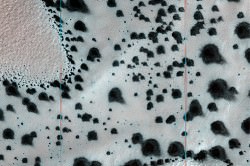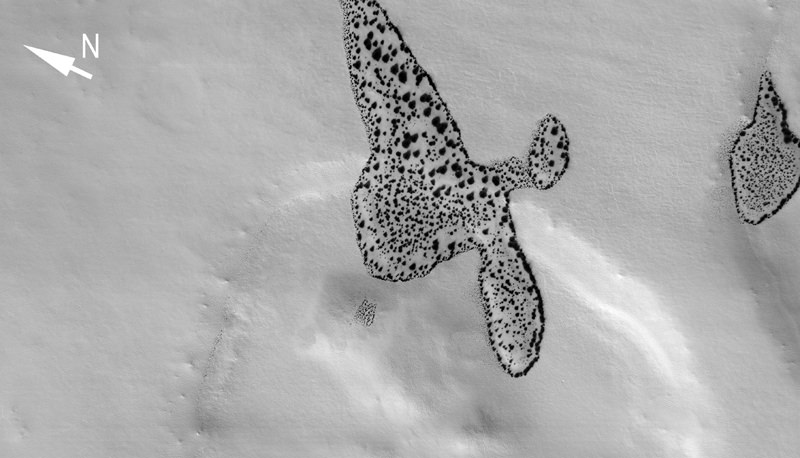[/caption]
This image is probably more suited to Nancy’s “Where In The Universe” series, but judging by the resolution and surrounding landscape, it may be fairly easy to distinguish which planet and what instrument took the shot. Of course, this is Mars and the image was snapped by the astounding HiRISE instrument on board the Mars Reconnaissance Orbiter (MRO). Still… what is it? Apart from looking like a particularly large coffee stain, the answer might not be very obvious. However, once we realise this is an image of an ancient volcano covered with ice, the big question is, why has the ice melted in discrete patches when the rest of the landscape looks like a winter wonderland?
On January 16th, the MRO dashed above the southern hemisphere of Mars, over the famous Hellas impact basin. This large crater is very interesting for many reasons, particularly as the altitude distance from the crater rim to the deepest part of the crater bottom is 9 km. This means there is a 89% increase in atmospheric pressure at the bottom of the crater when compared to the planet average. The pressure is therefore high enough to entertain the thought that liquid water may be a reality in this region (if the temperature gets higher than 0°C that is).
There are also ancient volcanoes in the region, of particular note is the group of volcanoes called Malea Patera (as captured in the HiRISE image above). As Hellas is so close to the southern arctic (antarctic?) region, it is currently entering spring time, surface ice is beginning to melt as the Sun creeps higher above the Martian horizon. However, there appears to be areas of ice that are melting faster than others, and a pattern is emerging.

This basic ice melting mechanism is being singled out for what HiRISE is seeing on this ancient volcanic region. There are patches of dark rock melting the snow faster than the rest of the region as the Sun gradually heats the southern hemisphere. What is very interesting is the patches and shape of the melt region. Could it be an ancient lava outflow from a volcano? Are the patches sand dunes peppered with volcanic material? Or is there some other explanation? HiRISE scientists hope to take more images of Malea Patera as the seasons roll on to see how the ice continues to melt. It will be interesting to see what HiRISE finds under the ice during the summer…
Source: HiRISE


It’s images like this that bring home just how alien Mars really is.
I agree, this is a fascinating image of a fascinating planet. Mars continues to surprise us! The HiRISE camera has got to be one of the biggest assets we have on any spacecraft…
Giant amoebae from mars!!!
Run to the hills!!!!
Ian,
From the two photographs and more specifically in the “Detail of the melting ice on Malea Patera”, a distinct pattern is seen – as if there is a wind blowing effect from west to east.
Almost all Dalmatian patches have a pointed edge extending to the East.
Im going to say it and possibly be damned.
Its an ecology of biological matter.
Yes it could be geology, but why not biology, Black dunes, (absorb sunlight) they are seasonal so it appears) and the dunes themselves appear in satellite images like biological structures rather than geological matter.
Why is this not being discussed more? This should be exciting to everyone.
Damian
Reminds one of Iapetus, does it not?
I suspect the dark material to be similar to lampblack i.e. carbon soot. Martian lighting…sometimes in the form of dust devils, which are known to be electrified, or a similar current-carrying morphology, has disassociated atmospheric CO2 and deposited the carbon on the surface. I think the electrical origin conjecture is supported by the increasingly smaller, fractally similar appearance of the dark material as one looks to the edge of the formation. Melting solids don’t display that, certainly not at a very large macro scale.
I like Damian’s idea 🙂
It is theorized that photosynthetic plants on Earth are green because they evolved lower in the water column than the purple H2S bacteria. The purple bacteria sucked up the orange, yellow, and green wavelengths leaving only the red and blue wavelengths at the edges of the spectrum to reach the ancestral photosynthesizers.
Maybe we’re seeing black photosynthetic “algae” living in the wet sand of the Hellas Basin. Being black suggests they never had to compete with other photosynthesizers and by absorbing all wavelengths they’re more efficient than their Terrestrial counterparts.
If you go to the HiRISE website – you get to see the very hi-res images.
This is a truly bizzare – the larger the patches – the fewer of them there seem to be, and the boundry of the area is clearly defined – mainly by higher density smaller patches.
The patches are clearly warmer than the surrounding area, and the dark material that produces them seems powdery enough to be blown by the thin martian wind.
My guess is that there is some underground heating process at work – perhaps volcanic, perhaps radioactive, perhaps geological, perhaps some kind of exothermal chemical reaction. I realise this is an alien landscape, but it just doesn’t *look* like the kind of melt pattern you might expect from the processes described in the article.
Looking forward to the summer pictures which will (hopefully) provide the answer!
Most everybody is assuming that black is black and white is white.
This is not necessarily so as most, if not all, of these images from other worlds are the result of processing from wavelengths far beyond visible.
I looked at the HiRISE website and there is no obvious info on the original , whether it is IR or visible.
One jump to conclusion leads many down the same road, building theory on assumption.
The second, zoomed, image shows pink outside of the area of interest which reminds me of Snow Fleas which can turn snow pink in the springtime, but I would not project Earth onto Mars.
I will admit, however, that it could be seen as a growth pattern similar to bacterial cultures on agar.
Just my two cents…
Fire Up Google Earth v5 switch to Mars and focus in on dark areas.
The Black sand dunes exist in sheltered areas where water might have remained.
They appear to have (boundaries) that are not necessarily linked to the geology of the area.
Where they do appear. they do so as homogenized and localized groups rather then scattered by random forces.
With a bit of imagination its easy to imagine clumpy water rich soils with algal like bacteria permeating. (algal blooms?)
They are black to fully absorb the most energy from the sun. And bloom seasonally with prevailing conditions. (perhaps spreading by wind in the Martian summer)
My imagination is piqued by the patterns they form. Look around Syrtis Major on Mars.
A great example is the Crater floor in Nili Fossae region.
http://viewer.mars.asu.edu/planetview/inst/ctx/P02_001886_2049_XI_24N285W#start
One of the rovers got stuck in one of these (black Dunes) if I remember right.
This should be a focus for more research, if nothing else.
Damian
I don’t think its from dark rocks. The pattern looks odd, these rocks in a patch that crosses over a crater rim. I can see some white ones sticking up on the left side of the picture. Since they are up high they should have less ice on them to begin with and should have melted first or be clear of ice.
I have say its heating from below.
I remember a few years back someone though they discovered hot spots in a thermal picture in Hellas Basin and nothing more was ever said.
Later dudes!
Whatever they are… they are fascinating and worth keeping an eye on!